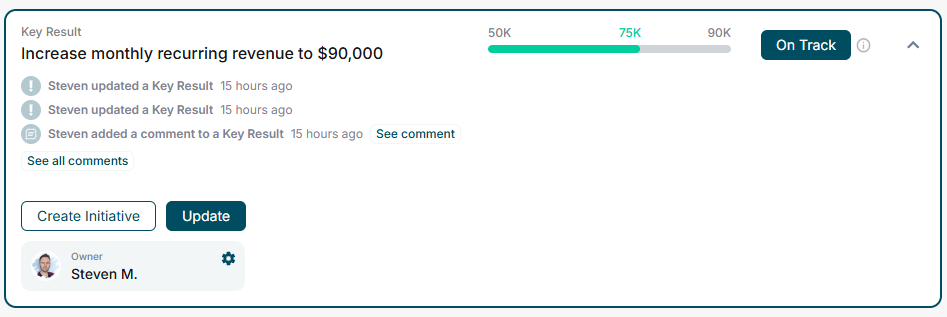Ever looked at your OKR dashboard halfway through the quarter and thought:
“Wait… who’s actually responsible for this one?”
A lot of startups have.
In our 2026 OKR benchmark report, one pattern stood out:
Clear ownership is one of the strongest predictors of follow-through.
Teams that assign a single accountable owner per OKR complete 26% more goals than those that don’t.
And that one number captures the entire story of why so many OKRs fail quietly - not because people don’t care, but because nobody really owns them.
When Everyone’s Responsible, No One Is
At the start of a new OKR cycle, optimism runs high.
Founders set ambitious targets. Teams nod along. Names get added - sometimes two or three per key result.
Then real life hits. Deadlines blur, priorities shift, and updates start slipping.
The issue isn’t motivation - it’s clarity.
Without ownership, accountability dissolves. A key result like “Improve onboarding activation rate to 25%” turns into a shared hope rather than a shared goal. Everyone contributes a little, but no one drives it over the line.
As one founder told us in our benchmark survey:
“The best advice I got? Assign a clear owner to every key result. If no one owns it, nothing moves.”
What the Data Says
Our report shows a direct, measurable link between ownership and outcomes.
Teams that assign a clear owner to every objective and key result complete 26% more of their goals on average. That’s not a small lift - it’s the difference between OKRs that live in dashboards and OKRs that actually drive progress.
But here’s the kicker:
Only 46% of teams say all their OKRs have a clear owner.
Another 45% admit “most” do, and nearly 10% say ownership is inconsistent or missing altogether.

When ownership is consistent, execution follows. But for more than half of teams, accountability remains patchy - and that gap directly impacts performance.
Why Ownership Creates Momentum
Ownership isn’t about hierarchy - it’s about clarity.
When one person knows they’re on the hook for a result, the dynamic changes from “we should improve this” to “I will make this happen.”
Here’s what shifts when ownership is clear:
- Decisions get made faster.
Instead of waiting for consensus, owners can act - or escalate - quickly. - Meetings become sharper.
Updates focus on progress, blockers, and data - not vague status reports. - Accountability feels fair, not fuzzy.
Successes get celebrated, and misses become learning moments rather than blame games.
As one COO from a Series A SaaS startup told us:
“The moment we stopped co-owning KRs, our updates got 10x better. We finally had conversations about progress instead of opinions.”
How to Assign Ownership the Right Way
Assigning ownership sounds simple - but it’s easy to get wrong. Here’s how to do it effectively (based on what we’ve seen in high-performing teams):
1. One Owner per Key Result
This is non-negotiable. Even if multiple people contribute, one person must be accountable.
They don’t have to do everything - but they own the outcome.
Think of it like a product launch: engineers, designers, and marketers all play a role, but one person owns shipping day.
2. Assign at the KR Level, Not Just the Objective
Objectives are directional (“Improve activation experience”), but KRs are measurable.
That’s where accountability lives.
Example:
- Objective: Improve onboarding experience
- KR1: Increase trial-to-active conversion from 25% → 40% (owned by Growth)
- KR2: Reduce average time-to-value from 7 → 4 days (owned by Product)
3. Add the Owner’s Name and Photo
It’s a small design choice that matters. When goals are visible with names and faces, accountability feels human. In OKRs Tool, this visibility is built in - owners show up directly in dashboards and updates.

4. Make Ownership Public
Don’t hide it in a spreadsheet.
Put ownership where everyone can see it - in dashboards, Slack updates, and review meetings. Transparency builds trust and clarity at the same time.
5. Review Ownership Each Cycle
Teams evolve. If someone leaves, changes role, or a project shifts direction - reassign ownership immediately. An unowned KR is the fastest way to lose progress.
How to Assign KRs in OKRs Tool
You can talk about ownership all day - but what really matters is making it visible and trackable. In OKRs Tool, assigning a key result to someone takes seconds:
- Open the KR → Click “Assign owner.”
- Choose a member → Start typing their name and select from the list.
- Click Assign → The KR is instantly linked to that team member across all dashboards.
From that moment, ownership is clear - everyone knows who’s driving the result, and updates automatically surface under their name.
Only Org Admins and Team Leaders can assign KRs, which keeps accountability structured and avoids accidental changes.
This small step ensures that every goal has a clear driver - and that accountability isn’t left to guesswork.

The Psychology Behind Ownership
Behavioral research backs this up: when people feel personally responsible for an outcome, they’re more likely to sustain effort over time.
It’s called the “endowment effect of accountability.”
When you “own” a goal, you value it more - and protect it from neglect.
That’s why OKRs Tool ties each key result directly to an individual profile.
Every weekly check-in is a subtle reminder: “This is yours.”
That sense of ownership - not pressure - is what builds consistent follow-through.
Common Anti-Patterns (and How to Fix Them)
Even experienced teams fall into predictable traps. Here are the most common:
Fixing even one of these patterns can dramatically improve accountability and follow-through in your next OKR cycle.
Final Thoughts
If there’s one takeaway from all this, it’s simple: every OKR needs an owner.
Ownership creates focus, and focus drives outcomes. It’s the bridge between writing goals and actually achieving them.
Before your next OKR cycle, take five minutes to run a quick audit. Look at every key result and ask yourself, “Is someone clearly accountable for this?” If the answer is no, that’s your next best improvement.
Assigning ownership might feel like a small change, but it’s the one shift that can transform your OKRs from wish lists into results.






